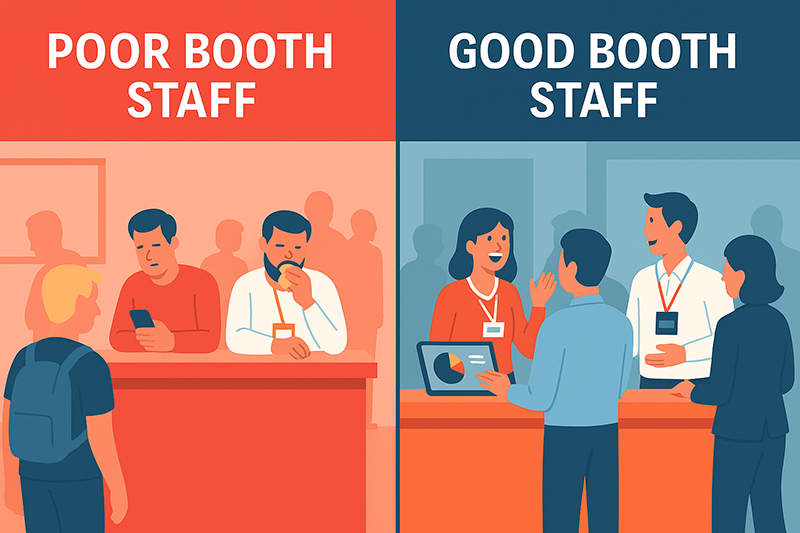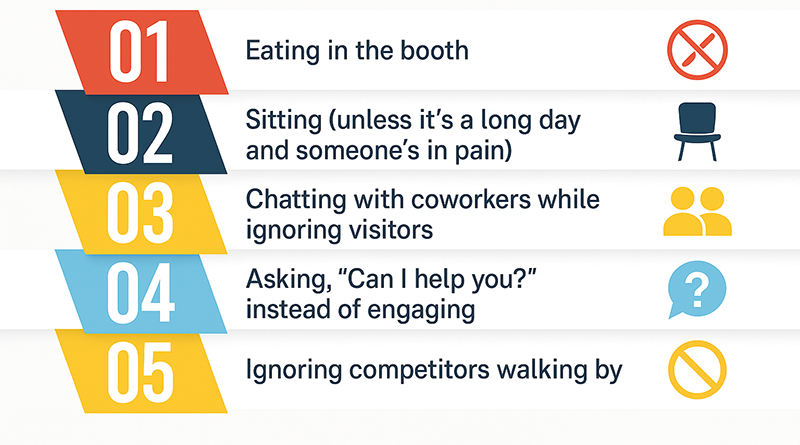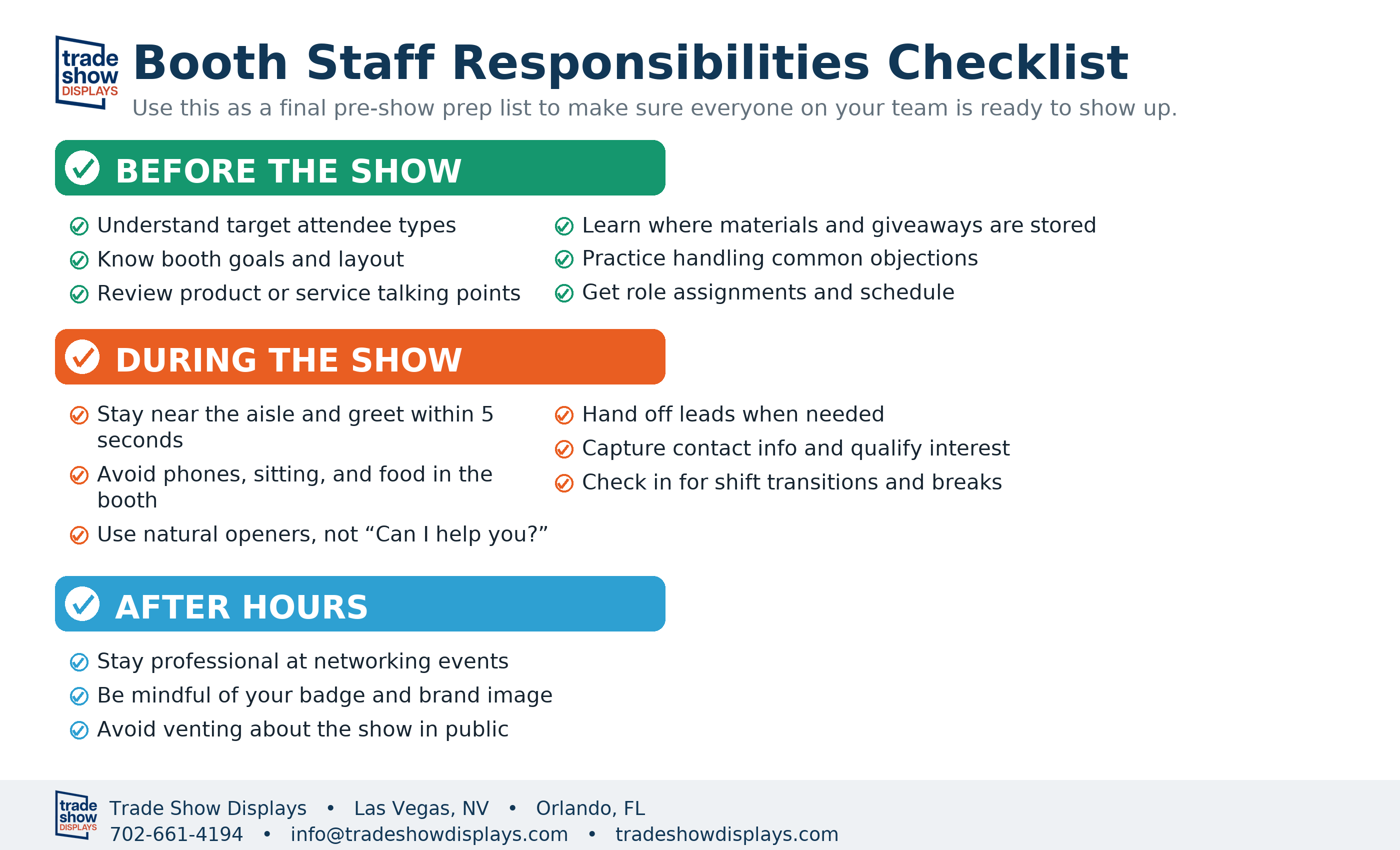Trade show booth staff responsibilities that drive real results

You spent $20,000 on a trade show booth. Your graphics are sharp. Your demo is ready.
But your team? They’re sitting behind the counter, sipping coffee and scrolling Instagram.
This is how great booths get wasted.
If your team doesn’t understand their trade show booth staff responsibilities, or worse, they’re treating the booth like a break room, you’re not getting what you paid for. This post will fix that.
Let’s talk about what your people should be doing inside the booth.
It Starts With Presence
The first job is simple. Be present. Not kind of present. Not nodding while scrolling.
Actually there.
Trade show attendees walk by quickly. They size up your booth and your staff before you even say a word. If your team looks bored or buried in their phones, visitors keep moving.
Signs Your Booth Staff Is Actually Present
- They make eye contact and say hello
- They’re standing near the aisle, not hiding behind counters
- They smile at strangers (yes, really)
- They greet someone within 5 seconds of stopping
- They’re not checking their email in plain view
At a recent show in Vegas, we watched two companies across the aisle from each other. One had three staffers standing close to the aisle, scanning badges and chatting. The other had two reps in branded hoodies, slouched in chairs, and quietly scrolling.
Guess who had a packed booth?
Assign Roles Before the Show
Too many teams show up with five reps and zero plan. Everyone waits for someone else to take the lead.
Instead, give your team clear roles ahead of time.
3 Booth Roles That Actually Work
If you’ve only got two people, combine roles. But make sure someone owns each part of the process.
Prep Them Like It’s Game Day
Would you walk into a big sales meeting without knowing the audience?
Same goes here.
Your booth staff needs to be more than warm bodies. They need to know what the booth is built for and how to handle conversations.
Want more ideas to keep visitors engaged from the moment they walk up? Check out our tips on how to improve attendee experience at trade shows for proven ways to make your booth a destination.
What Every Booth Rep Should Know
- Who your audience is
- What are the show's goals
- What the booth includes (video, demo, meeting table)
- How to qualify leads
- What to say when someone objects or hesitates
- Where to find backup materials, giveaways, or aspirin
- When and how to hand someone off to a teammate
- Where to store personal items (hint: not the counter)
We’ve seen reps freeze when someone asks, “What makes you different?” That should never happen.
Set a Schedule That Makes Sense
Without structure, booths either turn into ghost towns or group hangs. Neither helps your results.
Build a rhythm that includes booth time, breaks, and time to walk the floor.
Sample Half-Day Schedule
- 9:00–10:30 Booth duty
- 10:30–11:00 Walk the floor and scout other booths
- 11:00–12:00 Focused demos and booked meetings
- 12:00–12:30 Break
It’s easier to be present when you know when your next breather is.
Watch for Booth Behavior That Kills ROI
Your staff doesn’t have to say the wrong thing to drive people away. Sometimes, their actions do it for them.
Behaviors That Turn Attendees Off

- Eating in the booth
- Sitting (unless it’s a long day and someone’s in pain)
- Chatting with coworkers while ignoring visitors
- Asking, “Can I help you?” instead of engaging
- Ignoring competitors walking by
Try this: Ask your team to open with, “What’s been the most useful thing you’ve seen today?” It breaks the ice better than any script.
Don’t Forget Lead Capture
Every attendee conversation should go somewhere.
If your team doesn’t know what a qualified lead looks like, or where to send that lead once it’s captured, you’re going to lose track of real opportunities.
Set up a simple process that answers these questions:
- What counts as a hot lead?
- Where does it go once we collect it?
- Who follows up after the show?
Your team’s job is not just to talk. It’s to help you track, qualify, and follow up.
Turning conversations into real business starts after the show ends. Our guide to post-show follow-up strategies can help you convert leads into customers faster.
After-Hours Behavior Counts Too
The booth may close at 5. Your brand doesn’t.
Happy hours, hotel lobbies, breakfast lines. These are all touch points.
Your team doesn’t need to be formal at dinner. But they shouldn’t be sloppy either. No loud complaints about the show. No overindulging with a badge around their neck.
Set the tone before the flight leaves.
And If They’re Not a Fit?
Some people just aren’t made for booth work. That’s fine.
But if someone can’t answer basic questions or refuses to engage with attendees, don’t keep them out front. Reassign them. Shorten their hours. Trade shows are too expensive to waste time on people who don’t want to be there.
Your Booth Can’t Carry the Team
The structure might be clean. The graphics might pop. But it’s the people who make it work.
Don’t assume your team knows what to do. Show them. Train them. Set expectations. Then give them what they need to show up strong.
Because a great booth with a weak team? That’s just an expensive sign.
Ready to get more from your next event? Contact us to talk about booth design, staffing, and support that helps you walk away with more qualified leads.


